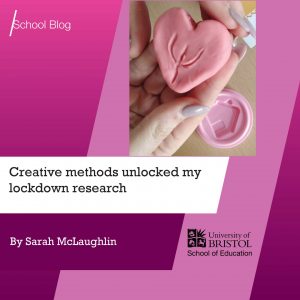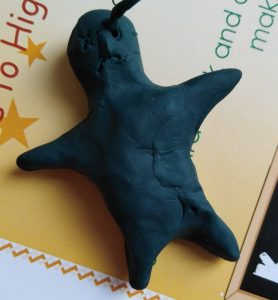 By Sarah McLaughlin, BA(Hons), MSC. PGCE, School of Education, University of Bristol (Doctorate in Education student)
By Sarah McLaughlin, BA(Hons), MSC. PGCE, School of Education, University of Bristol (Doctorate in Education student)
I commenced my Doctorate in Education journey in September 2018 – pre Covid! Little did I know that a pandemic would join me along the way and threaten to hinder my research.
When Covid rules put a halt on face-to-face data collection, I had big decisions to make. Should I wait it out until restrictions lift? After all, this would blow over after a few months, right?! Or do I change my methods? I needed to find a way of giving my participants a voice and allowing them to tell me their stories and reflections so that I could ask questions and understand how they constructed their return to education as mature students.
Researching mature female students on an Access to Higher Education course
My research sought to understand the lived experience of mature working-class women progressing through an Access to Higher Education course. I planned to conduct focus groups and one to one semi-structured interviews. Having a rapport and enabling the women to be relaxed was essential for them to open up to me, and I initially assumed the best place for data collection was in my classroom. It was neutral ground, and my classroom boasted big windows which looked out onto the sea. It was colourful, airy and there was a positive vibe about it. I displayed student work on the walls and loved being creative. In my classroom, we do learning. We recreate our understanding of theories and facts through poster making, fake front newspaper creations, and displays to remind students of terminology. I was fixed on the idea of my classroom being the appropriate place to host my data collection. Then lock down threatened to lock down my research!
The alternative was to meet online, physically apart from the women. Online meetings seemed so clinical. It would be hard to read body language, and I was unsure whether the women would feel relaxed or focused. I decided not to delay the data collection and forge ahead using Microsoft Team. On the plus side, I could use the transcription option, which saved time, and my students were experienced in using Teams for lessons during the January 2021 lockdown period so knew how to navigate and access it. But It didn’t quite sit right with me; what could I do to enhance the experience for them? Then it came to me. What do I do in my classroom to relax students and help them articulate their understandings? We use PlayDoh!!
Creative participatory research
I decided to use Playdoh as a creative participatory research method. Ten of my 29 participants were able and willing to engage with PlayDoh. Adopting creative methods involved the construction of data and knowledge by crafting models as a way of helping participants to articulate their thoughts and feelings and solidify some of the abstract concepts discussed, such as identity and pride. I took screenshots of the models to include them in my thesis.
Participatory creative methods allow participants time to reflect upon their lives without the direction of an intrusive research voice (Mannay, 2016), and Abrahams and Ingram (2013) reported modelling is a non-intimidating, useful and fun research tool. Furthermore, the decision to utilise Play-Doh was an outcome of the reflective nature of the research process, which found me thinking about the power relations and practices of research (Adkins, 2002; Skeggs, 2002) and considering Back’s (2007) assertion that visual methods are not the keys to the truth but are the tools that create them.
During the interviews, I asked the women to use Play-Doh to depict aspects of their educational journeys. I used the models and discussions to consider how students constructed their identities before and after their time on the Access to Higher Education course, which they had just completed. This resulted in thoughtful and complex responses and gave the women control over what they communicated.
Zaina’s poignant creation
Zaina (name changed) made a particularly poignant creation. She reflected upon how race and ethnicity impacted her education as a child and as a mature student. Her model depicted how she felt the journey as a Black Muslim woman compared to how she perceived the journey for White British women.

Zaina’s journey to HE was complicated by the overlapping effects of ethnicity, culture, gender and social class. She saw whiteness as a capital to be drawn on to provide an advantage which she displayed through her model as a brighter journey with more potential for a rainbow at the end.
A cathartic experience for participants
I asked each participant for feedback about their experience of their interview. All responses were positive, and it became evident the session was cathartic. It was time given to them to talk about themselves and reflect upon their hard work, achievements and bumps along the way. The PlayDoh modelling gave them time to consider and consolidate their experiences. They found it therapeutic.
Creating models helped the women articulate their responses, which generated a valid research output. I agreed with Rainford (2020) that the benefits of employing creative methods outweighed the challenges, and offering participants the choice to use PlayDoh ensured only those who were creatively confident (Kelley & Kelley, 2012) or willing to have a go did so.
When I commenced my EdD I never would have envisaged a pandemic, a lockdown and the halting of face to face data collection. At first, it felt as though lockdown had stifled my research but synthesising online and creative methods, and using a bit of imagination, opened up my research. Adopting innovative methods provided a credible and sincere methodology and an enjoyable experience for my participants.
I am looking forward to submitting my thesis on 29th April – my son’s birthday!
More of the playdoh models:



Biography
Sarah is a Doctorate in Education student and Lecturer on the Teaching and Learning for Health Professionals programme at Bristol University.
Twitter: @sarah_sociology
